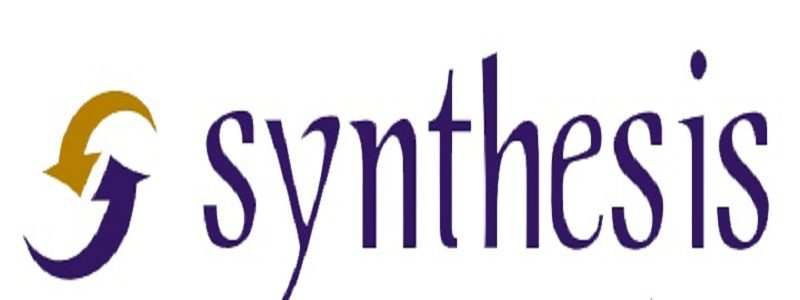
Synthesis Solution Protocol: A Demonstration, Part 2
Overview
In the first part of this two-part post, we looked carefully at some of pedagogical ideas and political context impelling us to design our Synthesis Solution Protocol, along with this instructional method’s objectives and implementation stages. This post will demonstrate what the five stages of this Protocol look like in a representative implementation scenario. The debatable issue for this demonstration is a common one in U.S. History or world studies classes, in a unit on World War II (1939 – 1945).
Stages One and Two: Issue Identification, Investigation, and Argumentation
The Synthesis Solution Protocol outline was posted in the prior post, but since it will guide our discussion of the implementation demonstration in this post as well, here it is again.

For this demonstration of the implementation of the Protocol we have chosen this issue, common in World History and U.S. History units on World War II (and made newly exigent by the crisis over North Korea’s recently acquired capability to strike the United States with nuclear weapons):
Was the United States justified in using atomic weapons against Japan in World War II?
A Debatifier post lays out resources and strategies for investigating this issue, including a full Media List and embedded short documentary videos. The post emphasizes argumentative evaluation with a Close Evaluation of Argumentation Activity specifically adapted to a prepared tracking form on a classroom debate on the issue. This activity could represent the argumentation necessary to set up the latter stages of the Protocol, but for this demonstration we chose to use the more common Table Debates format of classroom debating.
In the Table Debates format students are paired into teams defending one side or the other. Each two-person team is matched against another two-person team taking the other position. So each debate involves four students. For our demonstration we built up a model of one of these debates, starting with argument building on each side. For the sake of the fullness of the demonstration we mocked up three arguments to support each position. These argument builders appear here, and can be used to model secondary school argument building in any social science or history course.


It is worth noting that, while the arguments that support a position on the issue can be inter-dependent (e.g., “using atomic weapons was immoral” and “the U.S. could have demonstrated the power of atomic weapons to warn Japan”), each of the three arguments in these models are discrete and distinct, each are parallel to the other two, and each were selected based on its putative merit as one of the strongest arguments for its side in the debate. What qualifies an argument for selection is a combination of the quality of the evidence and reasoning supporting it and the relative difficulty of the opposing position’s refuting it.
The model debate that took place among our demonstration foursome was tracked on this model tracking form, known by competitive debaters as a flow sheet.
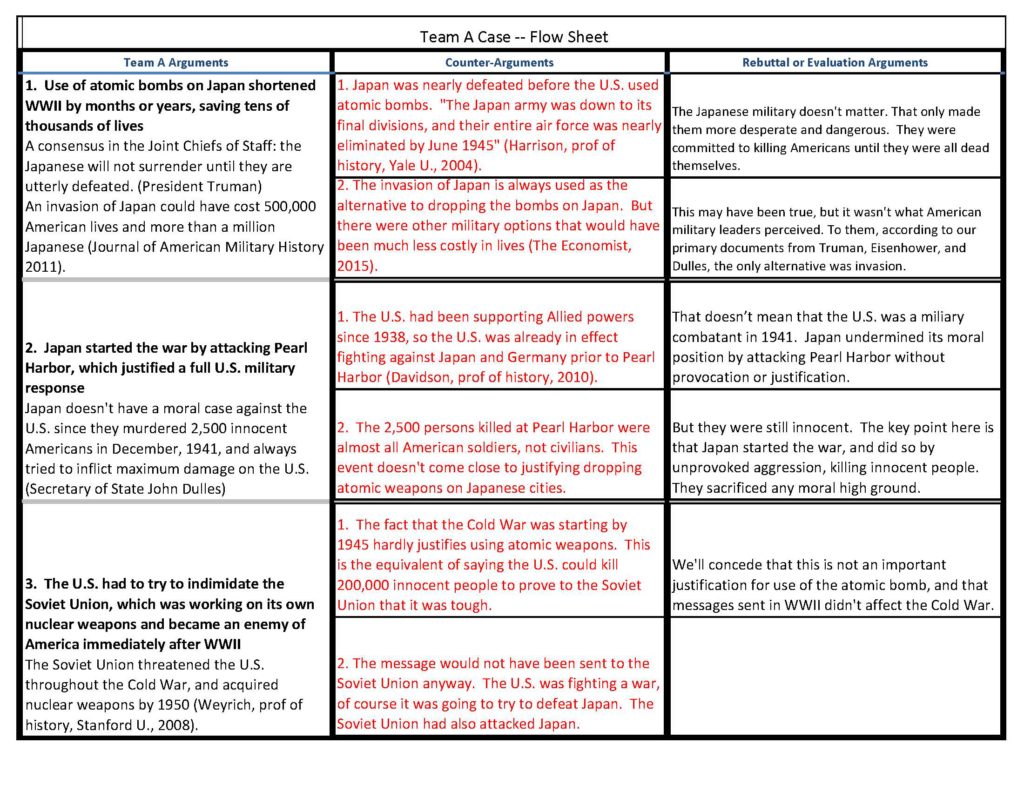
A few points of note on this particular model debate, as recorded by the debate tracking form.
The tracking form has very detailed summaries, more detailed than it will be possible for students to take in almost all instances during the debates they participate in. It functions as an idealized, aspirational model.
Opening (or “case”) arguments include the full argumentative claim and a summary of as much of the evidence and reasoning as the writer can get down and can fit. The claim here is in bold – it can be underlined by students writing on their tracking form by hand. The model tracking form generally includes a summary of one of the two pieces of evidence; that’s typical of more advanced examples.
Each opening argument is answered with two counter-arguments. It is a good idea to enforce as a routine making multiple counter-arguments. Counter-arguments are a primary form of refutation in a debate, and as such are a locus of the critical thought that students will do. They are difficult (until they become easier through practice), but that is a sign of the thinking they demand.
This debate features a combination of what are called “independent” counter-arguments and “critical” counter-arguments. The former include their own claim, evidence, and reasoning, coming together to form their own fact-based contradiction of the other side’s argument. The latter critique and attempt to undermine the evidence and reasoning used by the other side. To take an example, the first counter- argument made by the negative team against the affirmative’s second opening argument is the newly introduced and evidenced point that the U.S. had been supporting the Allied powers since 1938, so the 1941 raid on Pearl Harbor was not unprovoked. The evidence for this counter-argument is noted by the abbreviated citation in parenthesis. The second counter-argument is critical: it attacks the reasoning in affirmative’s second opening argument, actually in two ways. First, it states that even though there were 2,500 people killed at Pearl Harbor, these were military combatants, not “innocents.” Second, it disputes the implication that this attack, bad as it was, morally justified use of atomic bombs on two Japanese cities. This second counter-argument doesn’t contain its own new, complete argument, but instead it critiques components of the other side’s argument.
The final rebuttal arguments include a concession by each side of one of their opening arguments. Each side focuses on trying to win two of their original three opening arguments. In sequencing this final rebuttal, it is common in a debate to begin with the concession, do it quickly, and then spend the remainder of the speech on the arguments that the speaker believes are the reasons their side wins the debate.
It is interesting to note that each side decides to defend one argument based on morality and one argument based on the utilitarian question of whether the use of atomic weapons led to a higher death toll or not.
Given the speaking order, the negative side presents its rebuttal first, and therefore doesn’t have any responses from the affirmative to their counter-arguments to the affirmative’s opening arguments. This means that the only “red ink” on the flow sheets is in the “rebuttal” column of the negative case flow sheet, tracking the argumentation in response to the affirmative counter-arguments. The negative rebuttal can still make evaluative or comparative arguments in their final rebuttal, referring back to their refutation of the affirmative opening arguments (even if that comparison or evaluation can only be “flowed” on the negative case flow sheet).
The affirmative rebuttal – the final speech in a table debate – attempts to refute the counter-arguments to their opening arguments, flowed of course on the affirmative case flow sheet. But it can also – because of its sequencing as the debate’s closing speech – refer to and attempt to refute rebuttal arguments made by the negative. This it does in an effort to comparatively evaluate the clashing arguments (in its favor). And this appears on the flow sheet in black font (in this instance – the colors assigned to each side are arbitrary) on the negative case flow sheet.
Stage Three: Review and Evaluation
In this stage, each side carefully reviews and reflects on the argumentation in the preceding debate. Then each side completes a Review & Evaluation graphic organizer. Models of these forms, completed in our demonstration of the Protocol on this issue of the use of atomic bombs in World War II, are provided in full here.
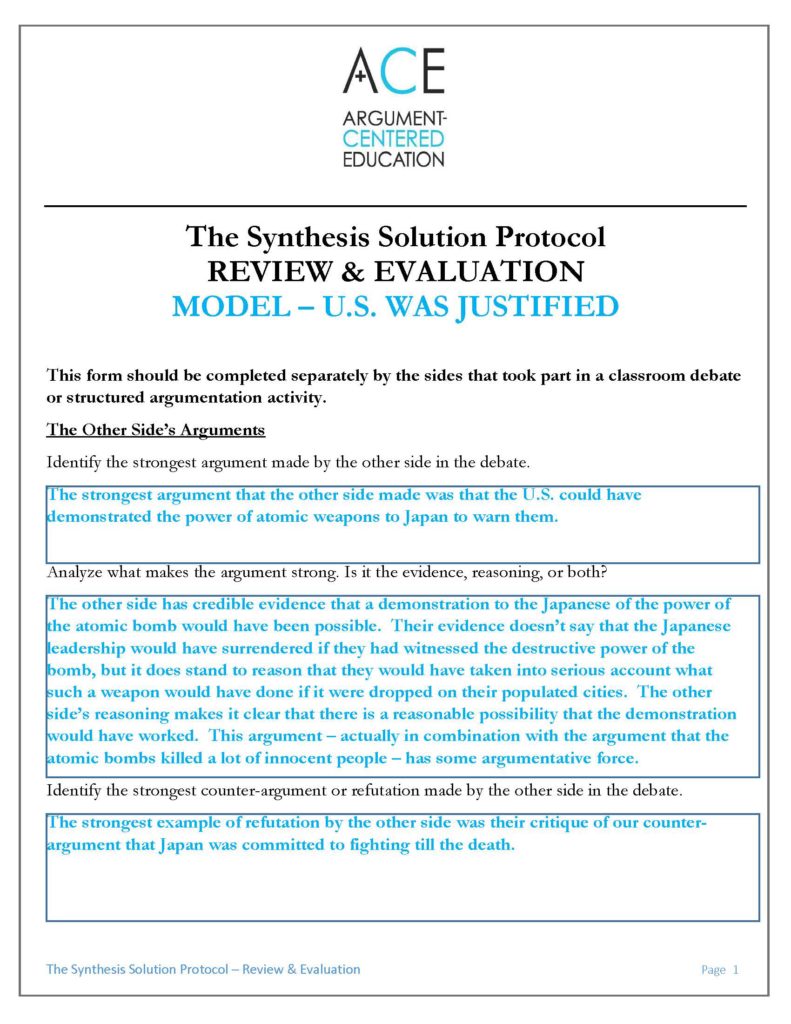
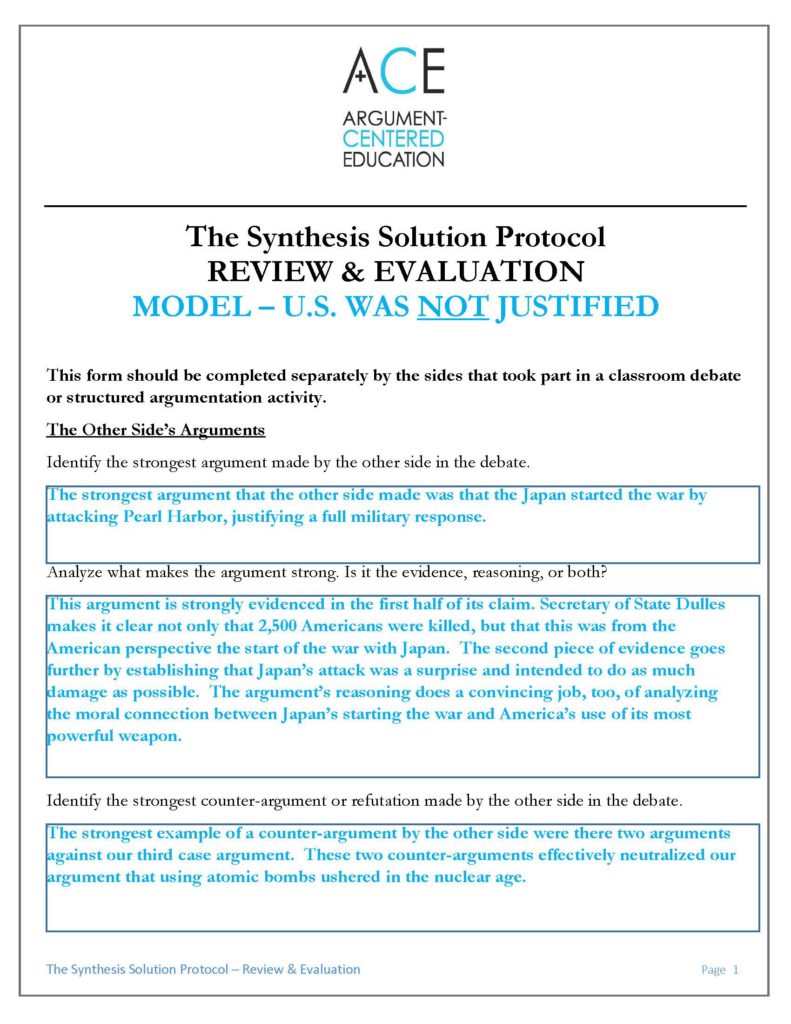
You should collect the Review & Evaluation forms as formative assessments, especially the first several times you use the Synthesis Solution Protocol. The kind of self-reflective, meta-cognitive thinking that this instrument asks students to practice is generally unfamiliar and non-normative. There is work that you will have to do to establish this rigorous practice as a norm and routine in your classroom, and you should expect the majority of student responses to be dashed off, unreflective, or defensive, at first. You will want to extol and showcase student models of this practice from those who approach or produce the norm you want to establish, and you should expect only incremental progress toward this goal. What this Protocol is attempting to do is ambitious and challenging – that is precisely why it is so necessary in our current classrooms and beyond.
There are several other principles of implementation and practice that are suggested by the above two models.
- Analysis of the strength of the other side’s best argument should include all components
Tell students to be sure that they comment on each component, beginning with its evidence, then review its reasoning, and finally discuss the force of its claim in relation to supporting the side’s overall position. To do this thoroughly, students will need access to the other side’s argument builders; they should exchange them in advance of completing the Review & Evaluation graphic organizer.
- Encourage students to identify the other side’s most effective counter-argument to a different argument than the one they select as their weakest
This helps ensure that students think more deeply about the other side’s critical thinking and the argumentation it generates in the debate. A good example of this is in the affirmative side’s (the U.S. was justified) Review & Evaluation form. The weakest argument that they made they identified as the Cold War argument (their third argument in their opening case). But the strongest counter-argument that the other side made they identified as the argument that Truman had every motivation to say that Japan would have fought to the very last man standing, since he was trying hard to justify his controversial decision to drop atomic bombs on Japan. This is the kind of broader push in critical review that we’re looking for.
- Students should strive to be self-reflective and even self-critical in their evaluations
In a debate students are rewarded for being aggressive defenders of their position and their arguments, and skeptical critics of the other side’s arguments. In this activity, however, they should understand and come to recognize that they are rewarded for looking at their own arguments more objectively and even critically, and seeking out the strengths in the other side’s arguments. The affirmative side’s Review & Evaluation has a particularly strong example of self-critique of their third opening argument (the Cold War argument).
- Students should resist the urge to continue debating and limit their review and evaluation to the argumentation that has already taken place
Students can legitimately quality their critique of their own weakest argument, for example, by referring to refutation that they made during the debate, or by going back to analyze the original evidence and reasoning in the argument. What they cannot do during the Protocol, however, is what many will feel a very strong impulse to do – continue to respond to the other side’s argumentation during the post-debate, evaluation process. There would be no end to this back-and-forth, and therefore no evaluation that guides students toward a synthesis. As a teacher that we were working with recently put it, quite astutely, “Each debate is different, and each debate applies its own emphasis and development of the possible arguments that can be made on an issue.” The Protocol respects the argumentation that actually took place between students.
- Rather than extending the argumentation, the Review & Evaluation can refer to arguments that should have been made
The negative side’s Review & Evaluation form has an example of this. The negative didn’t fully develop the implications of their counter-argument that the Japanese military was significantly deteriorated by the summer of 1945. As the form states, the negative side should have stated explicitly that this argument backs up the warrant in the argument that the U.S. could have demonstrated the power of the atomic bomb, warning Japan into surrender. Since their military was crumbling, the likelihood that they would have heeded the warning of a super-powerful weapon was greater. So, thinking of what they should have said actually feeds into students’ self-critique.
Here is the Review & Evaluation blank form.
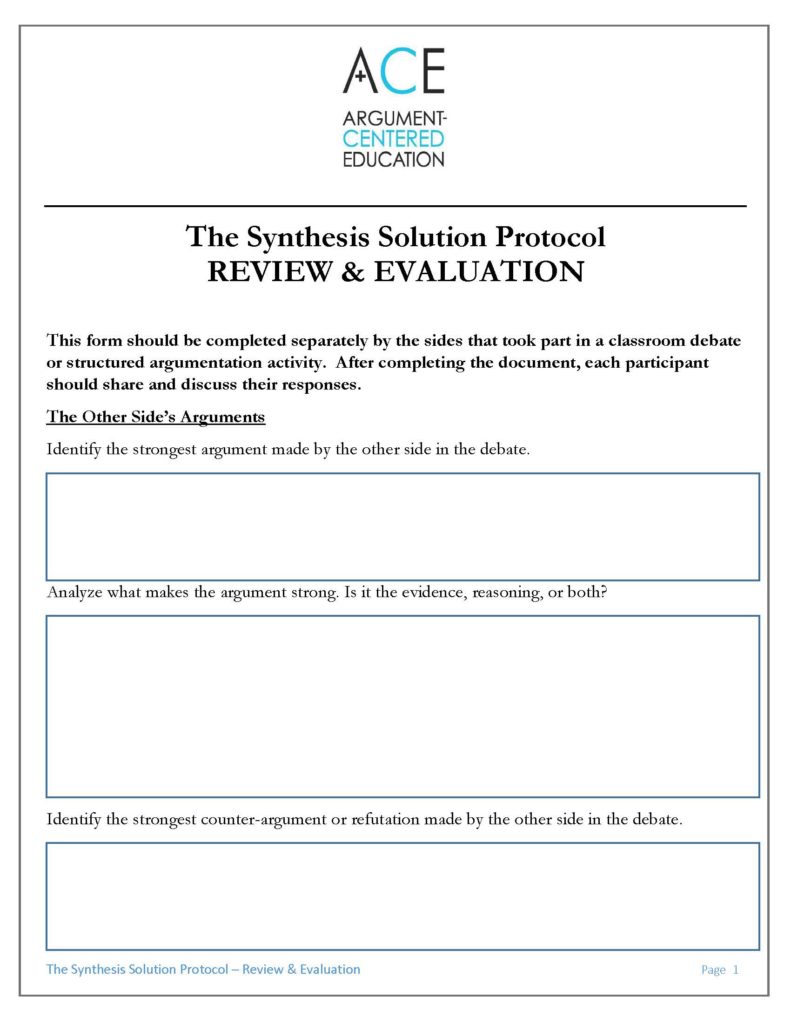
A variation in implementation is to pull out a third of the teams, after they have completed their argument building, to play the role of observers, judges, and leaders of the latter stages of the Protocol for the groups that are debating. For this variation, you should assign one two-person team to each of the tables of four debaters. These observers conduct their own review and evaluation, using their own form.
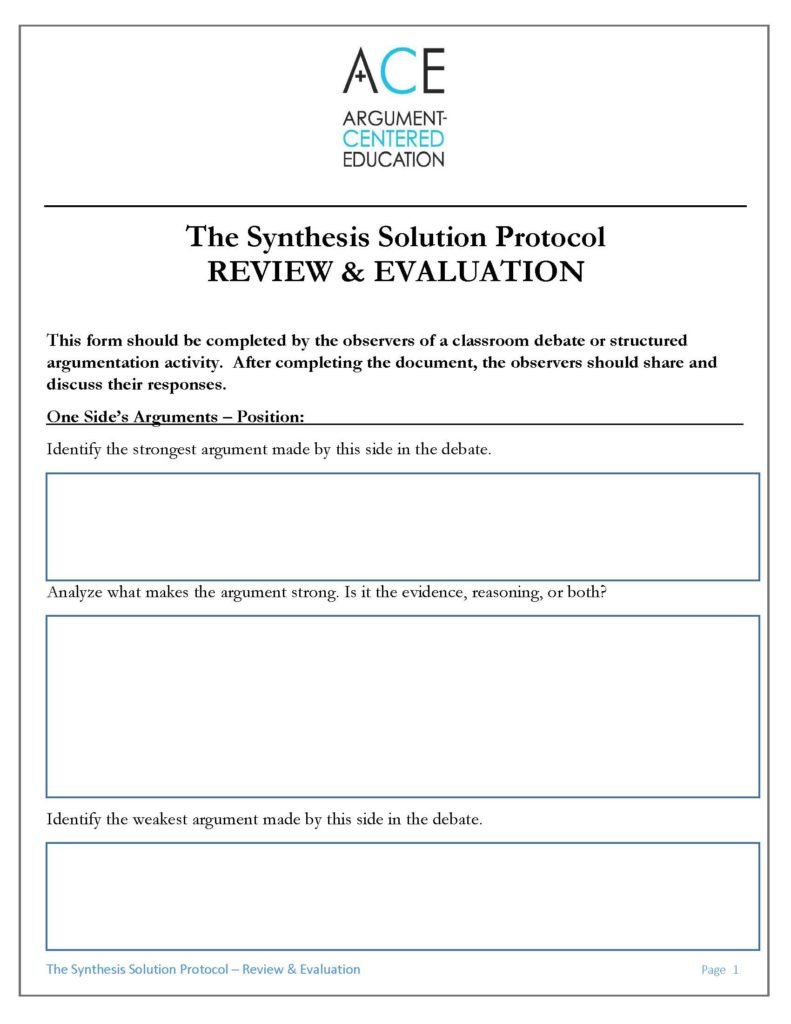
Stage Four: Search for Argumentative Common Ground
Students move from the close review and evaluation of argumentation into a discussion of argumentative common ground, as well as an acknowledgment of the places where argumentation has to be resolved in favor of one side or the other, based on the significant weight of evidence and reasoning. Observers – if you are using this variation – should lead the discussion. Otherwise, students can alternate leading the discussion, with one student leading each of the four headings. Each student should make their own summary of the discussion that takes place in response to each question, and should turn those summaries in for formative assessment.
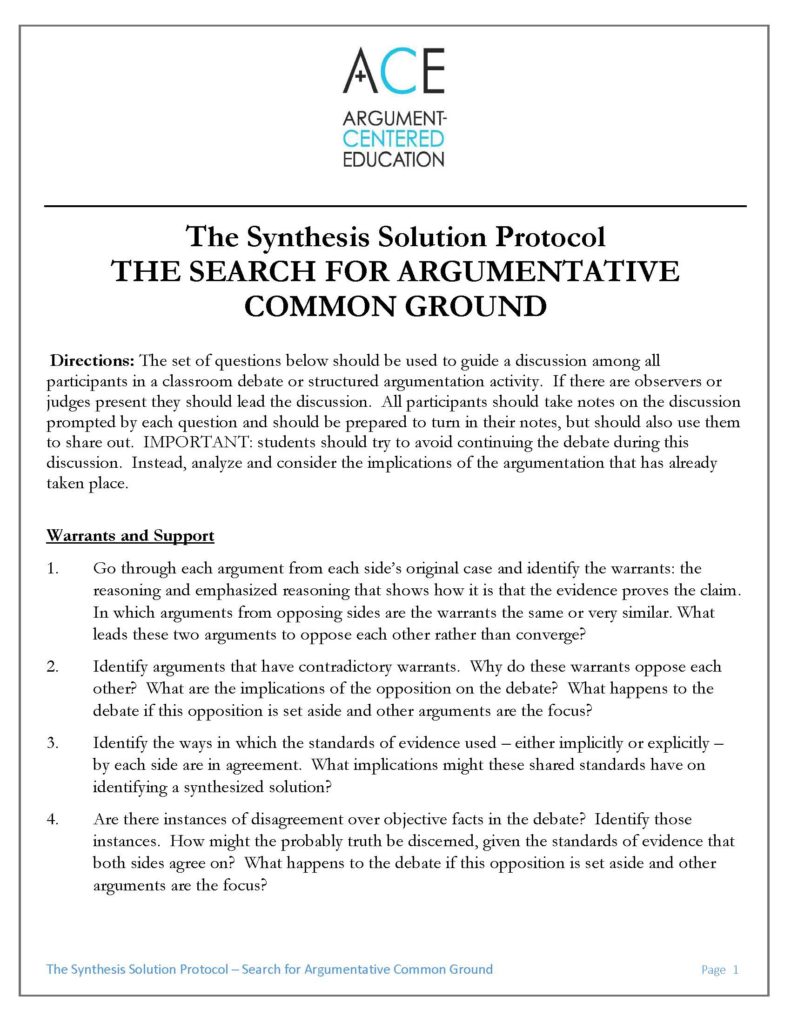
What follows are brief exchanges from our demonstration implementation of the Protocol on America’s use of atomic bombs in World War II, followed by a brief summary of the exchange, that might appear in the summaries of this search for argumentative common ground that students turn in. For these exchanges Antonio and Angela will be on the affirmative team (the U.S. was justified in using atomic weapons in WWII) and Nancy and Nathaniel will be on the negative team (the U.S. was not justified).
Warrants and Support
- Go through each argument from each side’s original case and identify the warrants: the reasoning and emphasized reasoning that shows how it is that the evidence proves the claim. In which arguments from opposing sides are the warrants the same or very similar. What leads these two arguments to oppose each other rather than converge?
Angela: Our argument that Japan started the war by killing innocent people at Pearl Harbor has a common warrant with the negative team’s argument that using atomic weapons on Japan was immoral because it killed innocent people. In both instances, the arguments rely on reasoning that says that if an attacker is deliberately killing innocent people during wartime, that attacker is acting immorally.
Nathaniel: Well, one side certainly killed a whole lot more innocent people than the other.
Angela: That is true, but even so, the reasoning applies to both: killing innocent people, even in war, is wrong and should be avoided.
Nancy: I see another commonality of warrants. Our second argument contains reasoning that says that acts of demonstration of military power are effective in communicating messages between nations and that they change other countries’ behavior. And your third argument, having to do with America’s desire to intimidate the Soviet Union during the Cold War, contains the same warrant. This argument only holds up initially if it includes this reasoning.
- Identify arguments that have contradictory warrants. Why do these warrants oppose each other? What are the implications of the opposition on the debate? What happens to the debate if this opposition is set aside and other arguments are the focus?
Antonio: Another way to view the relationship between our second argument – that Japan was at fault for starting the war by attacking Pearl Harbor – and your first argument – that using atomic bombs on Japan was immoral because it killed innocent people – is that the reasoning is NOT consistent. The full implication of our argument is that even a very strong U.S. response to the Pearl Harbor attack was morally acceptable since the Japanese first strike lifted any ethical restrictions on how we responded.
Nancy: It just seems to us, though, that it is inconsistent to say that Japan attacked innocent people, which was wrong, and that justifies America’s attacking innocent people. It seems like in both cases, killing innocent people is wrong.
Nathaniel: I think I have an even more important pair of contradictory warrants. Our second argument includes reasoning that suggests that Japan was persuadable to end the war through means other than a full-scale land invasion or the total destruction of two of their cities. That’s the key connection between the evidence that says a demonstration was possible, and the claim that a demonstration would have been a much better alternative to using the bombs. Your side, however, has reasoning in its first argument stating that the only realistic other way of ending the war was a land invasion of Japan. That connects the evidence that says a land invasion would have killed hundreds of thousands of people and the claim that the alternative to using the bombs was worse.
Angela: I actually think that this is a difference in warrants that we can’t set aside. This question over what the real alternative would have been to using the bombs is, to me, the whole debate.
Antonio: Or at least a whole lot of it. One contradiction in warrants that I think we can put aside is the one in our third arguments. We argue that scaring the Soviet Union with nuclear weapons actually created a pretty stable Cold War period. You argue that using the bomb in World War II brought in a very dangerous nuclear age. The contradictory reasoning here has to do with whether the period after World War II – like the second half of the 20th century, maybe? – was a peaceful one or a really risky one. I say we can set this contradiction aside because neither of us extended these third arguments in our final rebuttal speeches. We both kind of gave up on them.
Nathaniel: Conceded them, I think is the language that Ms. Benthuysen wants us to use!
- Identify the ways in which the standards of evidence used by each side – either implicitly or explicitly – are in agreement. What implications might these shared standards have on identifying a synthesized solution?
Nancy: I actually think that the standards of evidence that both of us used in this debate are largely the same, or at least very similar. Both of us use historical evidence that is from primary and from secondary sources. You had evidence from a primary source, Secretary of State John Dulles, that seemed very credible that the Japanese deliberately tried to cause the most amount of damage when attacking Pearl Harbor, for example. And we had evidence from secondary sources on how many people were killed in Hiroshima and Nagasaki, and what percentage of them were children, as an example of credible secondary source evidence.
Angela: We have been learning how “to think like a historian,” and I think the debate showed those skills. We both tried to read evidence carefully. We noted where we didn’t think your evidence from Professor Weyrich was complete enough to support your third argument, for example. We also agreed that corroboration of evidence is important. It would have been good to have had additional sources speak to the number of persons who would have died in a U.S. invasion of Japan, for instance.
Nathaniel: What I’m thinking is that the secondary sources, especially like the professors who do very careful studies and research on this historical question, are a higher standard of evidence, for both of us, than are primary sources. Your rebuttal argument to our evidence from President Truman was really devastating, I have to admit. Of course Truman was concerned about his decision to use atomic bombs, killing all those people, all those children. So you were right when you said that he had every reason in the world to say that the Japanese would have never surrendered unless we did that – or did something worse than that.
- Are there instances of disagreement over objective facts in the debate? Identify those instances. How might the probably truth be discerned, given the standards of evidence that both sides agree on? What happens to the debate if this opposition is set aside and other arguments are the focus?
Nathaniel: I don’t think we disagreed much about the facts in this debate. For example, we put forward that 200,000 Japanese people were killed by the atomic bombs. There was no debate about that.
Antonio: That’s true, but I see two big factual questions that we differed about. One was how many people would have been killed in a ground invasion of Japan if the U.S. did that instead of dropping the bomb. The other is whether Japan would likely have been persuaded by a demonstration of the power of atomic weapons if we had done that. I’m not sure this second one is a factual question. It’s certainly not a factual question in the same way as estimating the number of people who would have been killed in an invasion. That’s like a numbers question. This is a question I guess of probability? What was the probability that Japan would have been so impressed by or just afraid of the power of nuclear weapons that they would have ended the war right then. It’s only a factual question in the sense that historians can look to what the Japanese leaders were saying among themselves, and what kind of decisions they had been making throughout the war, and what maybe the political calculus was inside the leadership circle at the time – like who supported doing what, and how powerful was each side. There are facts here to look at, I think, even if the answer would never be 100% certain.
Nancy: But now we have to answer what we would want to do to find out how to resolve the factual differences in the debate. I think that Nathaniel said it well – and Antonio did too. We need secondary sources, written by unbiased historians or researchers of World War II history, maybe from both the U.S. and Japan, who can look at all of the available information and documents from the period, and write arguments about their conclusions. Then we should evaluate those arguments and choose to put forward the best supported and best reasoned to come to our own conclusions about these factual disputes.
Clash and Compatibility
- As the debate evolves, particularly into the final evaluation of arguments, crystallize the nexus points of opposition. What is each side’s strongest argument, by the end of the debate, and why?
Nathaniel: I think a lot what we have already said applies here. The debate I think really comes down to two things.
Nancy: Nexus points, you mean.
Antonio: I thought Ms. Benthuysen calls them micro-debates.
Nathaniel: Right, two things, as I was saying. One of them is the whole question of what was the alternative. Was a land invasion the only alternative being considered? If it was the only alternative being considered, should there have been other alternatives considered? Also, how many people would have actually likely have died in a land invasion? The other thing the debate comes down to is morality. Did the Japanese attack on Pearl Harbor mean that the U.S. was justified in doing whatever it felt it had to in order to defeat the attacker? Or was the use of nuclear weapons on cities made up almost entirely of civilians, most of whom were children?
Angela: I think our best argument was that there was no proven, reliable, effective, and trusted alternative other than a land invasion, and that a land invasion would have been worse than using the bombs. And I think your best argument is that killing 200,000 Japanese civilians, more than 100,000 of which were kids, was immoral.
Nancy: I agree with Angela.
- Which arguments, on both sides, are either conceded explicitly or granted to be true implicitly (“Silence = Assent”)? Are there broader implications on the debate to these concessions, and if so what are they?
Nancy: As we said earlier, both sides conceded their third opening argument. There weren’t any missed arguments – both sides were too good for that!
Nathaniel: Do you guys think there are any broader implications of either of the conceded arguments?
Antonio: Someone might try to say that when we concede that the need to stand up to the Soviet Union doesn’t justify killing innocent Japanese people we are kind of admitting that killing innocent Japanese people wouldn’t be justified by their attack on Pearl Harbor, either. But I think that would be a stretch. There were a lot of ways to stand up to the Soviet Union, we didn’t need to destroy Japanese cities to do that. But there weren’t a lot of ways to defeat an enemy country that attacked us first. So, no, I don’t think there are any broader implications to the conceded arguments – either this one or the “nuclear age” one.
- How can the strongest arguments that remain standing by end of the debate – the nexus points of opposition – be configured in such a way that they can be made mostly compatible with each other? How would they have to be modified to do this?
Angela: I think this question is a lot like the last one we have to answer, number 10, where we give our synthesis solutions. But I’ll say this. There should be a way to put together the strongest argument from each side. It might have been possible to do some sort of demonstration of the atomic bomb with a specific deadline by which the Japanese leadership would have to surrender or be faced with our dropping it on at least one of their cities. If they didn’t give up b the deadline, then we would have had no moral choice but to use the weapon.
Nancy: I think maybe demonstrating the power of atomic weapons, but more as a bluff than a promise to use them. We could have followed up that demonstration with a land invasion, if the Japanese didn’t surrender by the deadline.
Antonio: I might go the other way. Demonstrate the power of atomic weapons, but simultaneously launch a ground offensive. This could make it doubly clear to the weakened Japanese military that the end was inevitable and that it was near. Then, by the deadline, drop the atomic bombs if they don’t surrender.
Nathaniel: I like Angela’s idea, but I would add something to it. I would add that the first atomic bomb would be dropped on a third-tier Japanese city – maybe half the size of Hiroshima. We would give the Japanese a list of their cities, divided into three tiers. We tell them that if they didn’t surrender five days after the first demonstration we would drop an atomic bomb on one of their third-tier cities. We would give them one week to surrender after that. If they still did not surrender, we would use a second atomic bomb on one of their first-tier cities.
Resolving on the Merits
- Are there arguments on either side whose evidence and reasoning overwhelm the effort the other side makes to refute them? Identify these arguments, and draw out the implications for any synthesized solution if these arguments have to be acceded to by all sides.
Nancy: As we’ve been discussing, I do think our argument on morality is an argument that doesn’t get refuted in this debate. If you look at what the counter-arguments are, I don’t think they stand up. Sure, war itself is immoral, but does that mean that literally anything goes, once war is declared? A soldier could go through an enemy town and behead every child under 8 years old and we would just say, well, that’s war, the soldier’s behavior is perfectly moral. And wouldn’t this mean that Adolf Hitler’s behavior was perfectly moral – after all, the Holocaust occurred during World War II. I know that not all of the points were made in the debate, but we did point out the gist: that there have to be degrees of immorality in war, and indeed there are the Geneva Conventions, current rules of war.
Angela: And truthfully, our other counter-argument basically says that even if using the bomb was immoral, the alternative would have been even less moral, because more lives would have been lost. That does assume that the only alternative to using the bomb was a land invasion of Japan.
- Are there arguments on either side that are thoroughly refuted by overwhelming counter-arguments, to the point that no reasonable observer of the debate could believe that argument any longer to be true? Identify these arguments, and draw out the implications for any synthesized solution if these arguments have to be rejected by all sides.
Antonio: I think that only the two third opening arguments from each side were really thoroughly refuted. And that’s why they were both conceded by the side that originally raised them.
Synthesizing a New Solution
- Each participant should individually formulate their own position, in light of the above discussion. This position is called a “synthesis solution,” since it attempts to bring together the close review and evaluation of arguments, and the search for argumentative common ground where that can be found, and recognition of continuing difference where that cannot be reconciled. The synthesis solution should creatively seek the reconfigured compatibility of arguments, but should also incorporate the truths that emerge through clashing ideas. Each participant should present their synthesis solution and explain how it accounts for the discussion above – especially the nexus points of opposition. The group should then rank order its synthesis solutions for sharing out.
Angela: We each already outlined our synthesis solution, back up on question #7. So here what I think we should do is present a brief justification for it and the way it accounts for our discussion. My synthesis solution is simple and it combines the single best argument from each side.
Nancy: My synthesis solution also accounts for the best argument from each side, but it gives greater weight to the immorality of any use of atomic weapons on a city. It is also a solution that relies on the evidence saying that the Japanese military was very weak by the summer of 1945 and therefore that a land invasion wouldn’t be as awful as it had been estimated. However, it does risk the Japanese seeing through our bluff and therefore being less likely to be persuaded by the demonstration.
Antonio: My synthesis solution is more skeptical that a demonstration would actually persuade the Japanese to surrender, so it pushes them toward that outcome by beginning a land invasion right away. Its downside is that it would begin accruing loss of life on both sides immediately and it is possible that the invasion would complicate the demonstration. On the other hand, if you don’t believe that the negative side has made a strong enough case for the viability of surrender through demonstration, this option should appeal.
Nathaniel: My synthesis solution adjusts Angela’s by adding “time-outs” allowing the Japanese leadership to consider rationally its options before the U.S. would take its next actions. It also adds the “city tiers” concept, which might have pushed Japan toward surrender before our dropping the second atomic bomb (after all, my solution would put the destruction of Tokyo, Japan’s beloved capitol, on the table). The downside is that the Japanese might have tried to evacuate the tier-cities prior to dropping the bombs, diminishing their impact (though making them less immoral, too). This option might have been more confusing to try to push through diplomacy, too.
Stage Five: Collaboration toward a Synthesized Solution
In this fifth stage of our demonstration implementation, Angela, Antonio, Nancy, and Nathaniel all voted for the synthesis solution they thought best reflected the review and evaluation work that they did, and the discussion they had searching for argumentative common ground. Actually, each student was given two votes, and they were given the proviso that they could not vote for their own new position, though they could, if they chose, give both of their votes to a single other synthesis solution. So they could choose two of the remaining three, or one of the remaining three (giving that one a double-vote). If there were observers, they would have each gotten two votes, too. Votes were tallied after everyone cast their own secret ballot.
The top synthesis solutions were then rank-ordered:
1st Rank — Angela’s solution: to demonstrate to the Japanese, and then to follow up that demonstration with a deadline, after which atomic bombs would be dropped on Japan.
2nd Rank – Nathaniel’s solution: to demonstrate to the Japanese, with a deadline, after which a third-tier Japanese city would be bombed, then a delay, then a second bombing, this time of a first-tier Japanese city.
3rd Rank – Antonio’s solution: to demonstrate to the Japanese, while simultaneously invading the Japanese mainland, using atomic weapons after a period allowing Japan to surrender.
4th Rank – Nancy’s solution: to demonstrate to the Japanese, with a bluff to use atomic weapons.
The Protocol ended with a sharing out from each group of students presenting their synthesis solutions, with their justifications, in ranked order. A final argument essay culminated the unit, in which each student argued for the position that they discovered through this extensive inquiry is the truest and most defensible.
Final Thought
I don’t always agree with the New York Times columnist and public intellectual David Brooks; in fact, I often disagree with his conclusions and claims, even while I find his argumentation often skillful and deft. This excerpt, though, from a recent column on political moderateness has a few thoughts whose articulation bears on the Protocol and its origin and objectives, and are worthy of our reflection.
The truth is plural. There is no one and correct answer to the big political questions. Instead, politics is usually a tension between two or more views, each of which possesses a piece of the truth. Sometimes immigration restrictions should be loosened to bring in new people and new dynamism; sometimes they should be tightened to ensure national cohesion. Leadership is about determining which viewpoint is more needed at that moment. Politics is a dynamic unfolding, not a debate that can ever be settled once and for all. . . .
Creativity is syncretistic. Voyagers . . . might combine left-wing ideas about labor unions with right-wing ideas about local community to come up with a new conception of labor law. Because they are syncretistic, they are careful to spend time in opposing camps, always opening lines of communication. The wise moderate can hold two or more opposing ideas together in her mind at the same time. . . .
Truth before justice. All political movements must face inconvenient facts – thoughts and data that seem to aid their foes. If you try to suppress those facts, by banning a speaker or firing an employee, then you are putting the goals of your cause, no matter how noble, above the search for truth. This is the path to fanaticism, and it always backfires in the end.
— David Brooks, 2017
The Synthesis Solution Protocol accepts that political (and many other debatable) issues are “a dynamic unfolding,” and that truths can come from a multiplicity of positions. The Protocol is syncretic in its very nature, and it pursues ideas from different camps, held together at the same time in students’ minds. And the Protocol is based on a thorough and very profound commitment to a search for truth.

